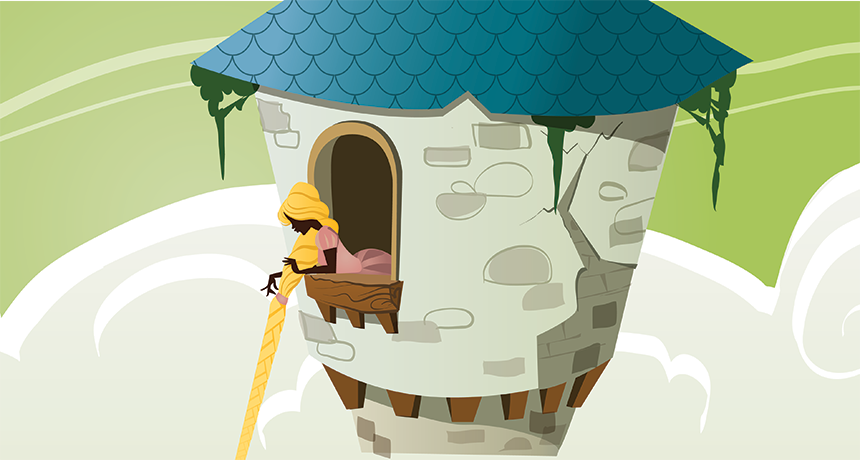Here’s why Rapunzel’s hair makes a great rope ladder
Hair is much, much stronger than you might expect

Rapunzel’s incredibly long hair makes a great rope ladder in the fairy tale. But could that work in reality?
cookgraphi/iStock/Getty Images Plus
In the classic fairy tale, the princess Rapunzel is trapped high in a tower. A dashing prince comes to rescue her. “Rapunzel, Rapunzel, let down your hair,” he calls. She unfurls her lengthy locks, draping them out the tower window. The prince then climbs up that magic hair to rescue his lady love. The story is obviously fiction. (If Rapunzel had such a handy ladder, one wonders why she didn’t just rescue herself.) But there may be a little truth behind a human hair-based escape. Science, it turns out, has found that hair is some super strong stuff. A prince (or princess) would actually have few problems climbing a rope made of human hair. The challenge would be growing such a lengthy mane in the first place.
Hair is strong. Really strong. A single human hair can take a force of 200 megapascals. This is its tensile strength — how much load it can take before breaking. Pressure is measured in pascals. A pascal is the amount of mass something can take per square meter of material. One megapascal is 1,000,000 pascals. In the case of a human hair, 200 megapascals is 20,000,000 kilograms of force per square meter of human hair.
Those are some big numbers. They mean that a single strand of hair is about half as strong as a piece of steel the same size, notes Ray Goldstein. He studies biological physics — the physics of living materials — at the University of Cambridge in England. Among the things he’s studied is the physics of ponytails.

Wen Yang is a materials scientist at the University of California in San Diego. She’s performed studies on the strength of human hair. She has compared hair’s strength to a finger lifting a loaded shopping bag. Not just any bag of food. If your finger were as strong as a bundle of human hair the same size, that one bag could hold 11,340,000 kilograms (2,500,000 pounds)!
Hair’s buffness comes from its structure, Yang explains. “You might [use an] example of the Russian matryoshka doll,” she says. “Inside the biggest doll (the hair), there are millions or more of the smaller dolls.” Those smaller dolls are tiny protein chains. They’re contained within an area called the cortex. The chains are layered together and covered with an outer coating called the cuticle (KEW-tih-kul). “The cuticle looks like a fish scale,” Yang says. It holds the protein bundles of the cortex together.
Beyond strength
Rapunzel’s hair is not only strong but also very long. That length might make her mane overall a little weaker, Rhett Allain notes. He’s a physicist at Southeastern Louisiana University in Hammond. Hair’s protein chains, he says, “are little atoms connected by springs. If you pull too strongly, the spring breaks.” No chain is perfect. In fact, a longer chain is more likely to have a weak point that snaps under the load. Rapunzel gets around this problem by throwing down a big braid or ponytail of hair, instead of a single strand. The individual protein chains might be weak, but they’re strong when bound together.
So strong, in fact, that Yang and Goldstein both estimate that some 500 to 1,000 hairs could support a full-grown human weighing about 80 kg (176 lbs). That’s not much hair. “A typical human head has about 50,000 to 100,000 hairs,” Goldstein notes.
The prince couldn’t just yank on the hair, though. “Keep in mind the hair is attached to the head via biological structures,” Goldstein says. Those structures are called follicles. And these aren’t as strong as hair. A single hair can easily be yanked out. So while the hair could take the weight, the scalp might suffer. The solution is to loop the long hair around a pole or hook, creating a pulley that keeps Rapunzel’s hair attached to her head.
Hair is both strong and flexible, and clearly would make a climbable rope. (The Mythbusters tried this successfully.) Why don’t we use it that way? In the past, Yang notes, people did use human hair for some things, such as sewing skin closed in surgery. But as a natural material, hair easily breaks down in the environment, Yang says. Not only that, the proteins in hair can be affected by temperature and the amount of water in the air (summer humidity can wreak havoc on a hairdo). Artificial materials are more consistent.
Hair also is pretty slick, Goldstein notes. There’s not a lot of friction — the resistance an object encounters moving against another object. Even when twisted into rope, he says, hair might be too slippery to hold together well. Regular rope make for an easier climb.
And of course, there’s the cultural aspect. “I think people would be squeamish about using human parts for anything like that,” Goldstein says.
But hair’s final weakness is that it grows slowly. The average human hair grows about 15 cm (or 6 inches) per year. At that rate, if Rapunzel were trapped in a tower 10 meters (32.8 feet) tall (about as tall as a four-story building), it would take 66.6 years for her hair to grow long enough to reach the base. That’s a long time to wait for a rescue.







